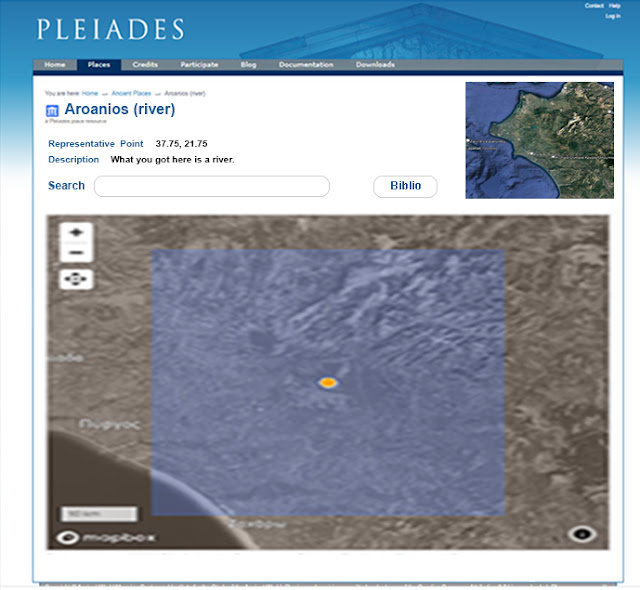 |
| Pleiades Commentary on Marmara (Pl. no. 540935) |
Sunday, December 11, 2022
How to create a gazetteer - what I've learned
Thursday, November 10, 2022
The Commentary on Pleiades
The Mycenaean Atlas Project is more than just a Bronze Age gazetteer. It is an accessible viewer for the entire ancient world - and at every period. It accomplishes this goal by integrating several very different data sets. Here's an example:
 |
The city of Aigion in Achaea as displayed in the Digital Atlas |
 |
Design of old and new interaction with Pleiades. |
 |
The new Commentary on Pleiades page (here for Belminatis, Pleiades 570152). |
Now I'd like to show a situation in which this commentary is invaluable.
 |
| Pleiades grouping 18 sites at the very same location: 37.25 N, 22.25 E. |
 |
Placement of Mount Boreion (Attica) in Pleiades, Topostext, and Mycenaean Atlas Project. |
Tuesday, November 8, 2022
Pleiades' pages and how to fix them
How Pleiades pages look:
How Pleiades pages should look:
In the revised version we've done away with the annoying zoom-in-from-outer-space and settled on a nice large map. Context which is lost by being zoomed-in is restored with the new spotter map which you see on the upper right. The spotter map is zoomed out (level 4,5?) so that you can tell at a glance where you are in the world.
All the ridiculous back-scratching, log-rolling, and mutual thank-yous are moved off to one of the tabs on the top. Users can click on that tab if they want to see whose bright idea this site was but - spoiler alert - they won't. I left the bibliography off of this new map but there is room for one or a button that will pop the bibliography up on a new window. New windows for subsidiary purposes are easy to write and not enough advantage is taken of this idea.
And, in fact, now that I look at it, we should lose the right-hand side margin which is crapped up with stuff that could easily be buttons. How about this:
 |
| The new and improved, user-forward, Pleiades page! |
Lean and mean. No wasted space. User's needs are foremost. The search field has been moved to where it belongs and is enlarged so as to be actually visible. Do you see the new Credits button? No? Good.
Instead we have something actually useful which is a new bibliography button. When you click on it you get a simple bibliography page (not shown). Now if Pleiades would just fix all the broken bibliography links and then link to something actually useful instead of a Zotero page.
Next, On to Peripleo! If it ever works.
Monday, November 7, 2022
The Pheneos Plain and the location of Lykouria
The town of Lykouria was only ever notable for the fact that Pausanias once passed through it and there are few or no other mentions of it in antiquity. Its isolation explains this. It is set in northern Arcadia, surrounded by mountains, and sitting on the edge of a remarkable karst landscape (the plain of Pheneus) to which there is no easy entrance or exit. Let's go to the map.
 |
The Pheneos Basin in more detail. Lykouria was located somewhere on the southwest edge of the valley, and just to the north of the jagged white line in the lower left that indicates a road. |
 |
The Pheneos Basin from the SE and looking NW. Lykouria was located somewhere by the center left corner of the superimposed line map. |
 |
| The hill on which Pheneos was built is in the center of this image. Here S is to the lower left. |
 |
| Springs of the Ladon where they emerge from underground at F7315. Original work of Chris Karagounis. All rights reserved to the creator. |
 |
| Pausanias's plausible route in green (R to L) |
Friday, September 23, 2022
When is an alona not an alona?

 |
| Alona (F3342) at Kerteszi in Achaea. Diameter as measured across the red line is 14+ m. As seen from above in Google Earth. |
 |
| Alona (F3342) at Kerteszi in Achaea. As seen from the road. Note the (formerly) paved floor. |
Monday, July 25, 2022
Scholarly Citation of Digital Resources; Proofing your Site against Link Rot
In my last posts, here and here, I started to deal with the idea of academic citation to digital resources. I explained that Elliott's insistence that Pleiades was 'citation-ready' is nothing more than a server rewrite rule. Such a rewrite rule does nothing for digital citation for the following primary reason:
Friday, July 22, 2022
Where broken links come from: the case of Peripleo
In my last post I suggested that rewrite rules were intended to make it easier for a user to search for an item on a web site. The general concept looks like this:
"This site can’t be reached"
- Elliott [2018] 45.
Blog Posts Concerning the Isthmian Wall
Since 2023 a number of posts concerning the Isthmian Wall and how we located its remaining segments, have appeared on this blog. This post ...
-
I learned from the Aegeanet bulletin board that the Arachne CMS databases are online. This includes a very large engraved seals data...
-
"You're traveling through another dimension, a dimension not only of sight and sound but of mind. A journey into a wondro...


















